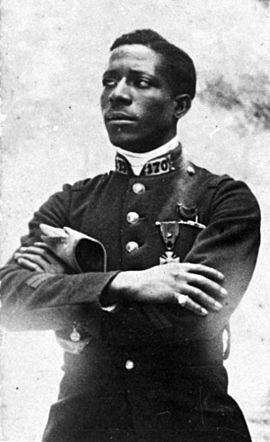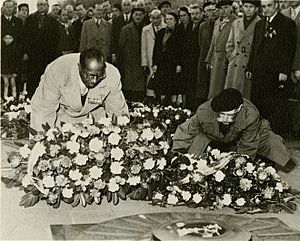Eugene Bullard facts for kids
Quick facts for kids
Eugene Jacques Bullard
|
|
|---|---|

Bullard in his uniform as a French Army caporal
|
|
| Nickname(s) | French: l'Hirondelle noire de la mort, lit. 'Black Swallow of Death' |
| Born | October 9, 1895 Columbus, Georgia, U.S. |
| Died | October 12, 1961 (aged 66) New York City, U.S. |
| Buried |
Flushing Cemetery
(40°45′6″N 73°47′58″W / 40.75167°N 73.79944°W) |
| Allegiance | |
| Service/ |
|
| Years of service | 1914–1919, 1940 |
| Unit | 170th French Infantry Regiment 51e Régiment d'Infanterie |
| Battles/wars | World War I World War II |
| Awards |
|
Eugene Jacques Bullard (born Eugene James Bullard; October 9, 1895 – October 12, 1961) was an amazing American who became a pilot, soldier, boxer, and jazz musician. He is famous for being one of the first black military pilots in the world. He flew for France during World War I, earning the nickname "L'Hirondelle noire," which means "Black Swallow" in French.
Contents
Early Life and Dreams
Eugene Bullard was born in Columbus, Georgia, in 1895. He was one of ten children. His family faced unfair treatment because of their race in the United States.
Eugene's father often told him stories about France. In France, slavery had been abolished, and people of all races were treated equally. This made Eugene dream of going to France.
When he was just 11 years old, Eugene ran away from home. He wanted to reach France. He traveled with a group of gypsies, learning to care for and race horses.
Later, he worked as a stable boy in Georgia. In 1912, he snuck onto a German ship in Norfolk, Virginia. He hoped to escape racial discrimination in the U.S.
Eugene arrived in Scotland and then moved to London. There, he became a boxer and performed in a show. A famous boxer helped him get fights in Paris. After visiting Paris, he decided to live there. He continued boxing and worked in a music hall until World War I started.
World War I Hero
When World War I began in August 1914, Eugene Bullard joined the French army. He enlisted in the French Foreign Legion because foreign volunteers could only serve there.
Fighting on the Ground
By 1915, Bullard was a machine gunner. He fought in major battles like the Somme and Champagne. He also fought in the fierce Battle of Verdun in March 1916.
During the Battle of Verdun, he was badly wounded. After recovering, he joined the 170th French Infantry Regiment. This regiment was known as "The Swallows of Death" because they were such brave fighters. Bullard earned the Croix de guerre for his bravery.
Flying High as a Pilot
While recovering from his injury, Bullard learned to fly. On October 2, 1916, he joined the French Air Force. He trained to be a pilot and earned his pilot's license in May 1917.
Bullard wanted to join the famous Lafayette Escadrille, a squadron of American pilots. However, it was no longer accepting new members. Instead, he became part of the Lafayette Flying Corps. This group included all American pilots who flew for France.
He flew over twenty combat missions. Some sources say he shot down one or two German planes. However, the French authorities could not officially confirm these victories.
When the United States joined the war, they looked for American pilots. Bullard tried to join the U.S. Air Service, but he was not accepted. At that time, only white pilots were chosen. He continued to serve with the French army until October 1919.
Life Between Wars
After World War I, Eugene Bullard returned to Paris. The French government gave him 14 medals for his service, including the Croix de guerre.
He became a jazz drummer at a popular nightclub called "Zelli's." He helped the club stay open late, making it very famous in Paris. Later, he bought his own nightclub, "Le Grand Duc."
His clubs were popular jazz spots. He became friends with many famous people, like singer Josephine Baker and musician Louis Armstrong. He even owned another nightclub called "L'Escadrille."
Bullard also opened a gym called Bullard's Athletic Club. It offered boxing, exercise, and massage. He trained well-known boxers like Panama Al Brown.
In 1923, he married Marcelle Eugénie Henriette Straumann. They had two daughters, Jacqueline and Lolita. They later divorced in 1935, and Bullard raised his daughters.
When World War II started in 1939, Bullard spoke German. The French government asked him to gather information on German citizens who visited his nightclub.
World War II and Return to the U.S.
In May 1940, Germany invaded France. Bullard volunteered to fight again. He served with the 51st Infantry Regiment, defending the city of Orléans.
Bullard was wounded during the fighting. He managed to escape to Spain and then returned to the United States in July 1940.
He spent time in a New York hospital, but he never fully recovered from his injury. In the U.S., he found that his fame from France had not followed him. He worked as a perfume salesman, a security guard, and an interpreter for Louis Armstrong.
In 1945, he tried to get his nightclub back in Paris, but it had been destroyed during the war. The French government gave him some money, and he bought an apartment in Harlem, New York City.
Later Life and Legacy
By the 1950s, Eugene Bullard was not well-known in his home country. He lived alone in his apartment, which was filled with pictures of his famous friends and his 14 French war medals.
His last job was as an elevator operator at the Rockefeller Center in New York. Most people there did not know he was the "Black Swallow of Death."
In 1959, he was interviewed on NBC's Today Show. He wore his elevator operator uniform during the interview. He received many letters from people who watched the show.
Eugene Bullard died in New York City on October 12, 1961, at age 66. He was buried with military honors in the French War Veterans' section of Flushing Cemetery in Queens, New York. His friend Louis Armstrong is buried in the same cemetery.
Honors and Recognition
Eugene Bullard received 14 medals and awards from the French government.
In 1954, France invited Bullard to Paris. He was one of three people chosen to relight the flame at the Tomb of the Unknown Soldier under the Arc de Triomphe.
In 1959, he was made a Chevalier (Knight) of the Légion d'honneur. This is France's highest award. General Charles de Gaulle called Bullard a "true French hero."
In 1989, he was honored in the first group of people inducted into the Georgia Aviation Hall of Fame. On August 23, 1994, 33 years after his death, the United States Air Force made him a second lieutenant. This was a special way to recognize his service.
On October 9, 2019, the Museum of Aviation (Warner Robins) in Georgia put up a statue to honor Bullard. There is also a sign in Columbus, Georgia, where he grew up, that tells about his early life.
Decorations and Medals
- Knight of the Legion of Honor
- Médaille militaire (Military Medal)
- Croix de guerre 1914–1918 (War Cross with bronze star)
- Croix du combattant volontaire 1914–1918 (Volunteer Combatant Cross)
- Combatant's Cross
- Medal for Military Wounded
- Médaille commémorative de la guerre 1914–1918 (World War Service Medal)
- Interallied Victory Medal
- Médaille engagé volontaire (Voluntary Enlistment Medal)
- Médaille commémorative de la bataille de Verdun (Battle of Verdun Medal)
- Médaille commémorative de la bataille de la Somme (Battle of the Somme Medal)
- Médaille commémorative de la guerre 1939–1945 (World War II Service Medal)
- Médaille commémorative des services volontaires de la France libre (Voluntary Service to Free France)
- Médaille des volontaires américains avec l'Armée Française (American Volunteer with French Army Medal)
Bullard also received the French Pilot's Badge and a special unit award called the fourragere.
In Popular Culture
Eugene Bullard's life has inspired many books and movies:
- In 1972, a book called The Black Swallow of Death told his story.
- Larry Greenly wrote a book for young adults called Eugene Bullard: World's First Black Fighter Pilot.
- The 2006 movie Flyboys has a character named 'Eugene Skinner' who is loosely based on Bullard.
- In the 2012 movie Red Tails, a character named Col. A.J. Bullard is named in honor of Eugene Bullard. This character represents the commanders of the Tuskegee Airmen.
- In 2020, a music project called Telergy released an album called Black Swallow about his life.
Images for kids
See also
 In Spanish: Eugene Bullard para niños
In Spanish: Eugene Bullard para niños
- Moroccan Division
- Escadron de Chasse 2/30 Normandie-Niemen - SPA93.
- Bessie Coleman
- Allan Bundy











